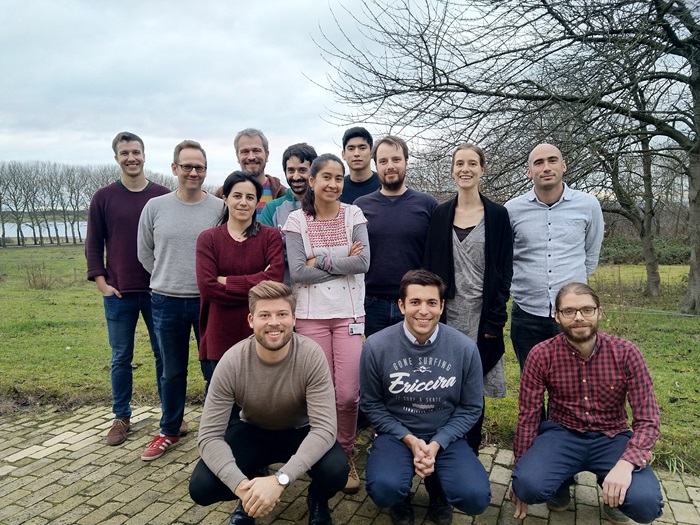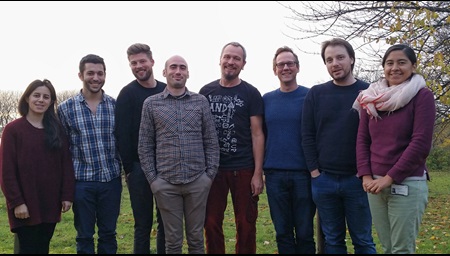
The SEEWHI group in December 2018

The group in December 2017
Peter Stanley Jørgensen - Resonant X-ray Ptychographic Tomography of P3HS Solar Cells
Imaging of the internal structure of organic solar cells is crucial for fundamental understanding of the internal processes and future developments. Of particular interest is the P3HT:PCBM active layer, the structure of which has proven challenging to image due to small differences in the refractive index of the two constituent materials. In this project Peter investigates avenues for increasing the contrast in the layer by replacing S in P3HT with Se (P3HS) and imaging just below and at the Se K-edge at 12.66 KeV.
Christian Rein - Photovoltaic CZTS absorber layer research
Cu2ZnSnS4 (CZTS) is a photovoltaic absorber material consisting of earth abundant and non-toxic elements. Only a fraction of the material is needed for solar cell production compared to conventional silicon solar cell due to its direct bandgap electronic transition properties. As nanochemist and material scientist, Christian’s task is to develop new CZTS inks for roll-to-roll printing, improve the solar cell architecture and characterize the properties of the individual parts at each step of the process until we have a functional solar cell.
Giovanni Fevola - X-ray phase contrast nano-tomography of 3rd generation solar cells
Giovanni’s goal is to quantify the nanostructure of organic and kesterite solar cells from absorber layer to electrodes and interfaces. He looks forward to obtain 3D reconstructions from ultra-high resolution X-ray projections, most likely from ptychographic tomography (ptychography is a form of phase contrast imaging, exploiting coherent X-ray illumination). That is why he is working to improve these sort of algorithms, and is open to exploit any other complementary X-ray technique.
Khadijeh Khalili - Modelling of ultrafast scattering experiments probing electronic dynamics in solar cells
Khadijeh will work on extending a newly developed model for imaging of instantaneous charge currents between atoms by hard X-ray resonant scattering. The case of conducting polymer hetero-junctions in nano-particles constitutes the first and main focus of her project. Extensions to other relevant systems will include defects in nano-crystals and organic-inorganic systems. Her work focuses on the theoretical description, with the purpose of designing and planning of appropriate model systems for imaging of instantaneous charge currents in photovoltaic processes. She is hoping to gain the fundamental understanding to design and interpret ultrafast resonant X-ray scattering experiments, to be performed at fourth-generation X-ray sources, the free electron lasers. For the latter, she plans to cooperate closely with the experimenters at DTU Energy and DTU Physics, on the design and interpretation of experiments with femtosecond time-resolved imaging of photo-physical processes in solar cell materials.
Tiago Ramos - Nano-scale 3D reconstruction of phase contrast X-ray projections
Tiago is developing and implementing diverse algorithms for X-ray image and tomography reconstruction.His work is mainly focused on ultra-high resolution phase-contrast imaging, provided by X-ray coherent imaging techniques.
At very small length scales (nanometer), mechanical instabilities, thermal drifts and/or equipment limitations are currently the main factors contributing for uncertainties in the source-sample-detector relative alignment. Such uncertainties are limiting the maximum attainable resolution provided by phase-contrast tomography, preventing our visualisation and correct quantification of the small structures that define the charge transport mechanism in solar cells. Tiago aims to correct for such uncertainties after data acquisition by developing robust computational algorithms for images alignment.
As a PhD student from the CINEMA project, Tiago establishes an additional connection with other academia and industry partners interested in imaging and modelling of diverse ‘Energy systems’.Ongoing collaborations with the NanoMAX beamline at MAX-IV are expected to return unprecedented high-resolution images of solar cells devices in the following years that could boost the research and development of organic solar cells.
Anders Skovbo Gertsen - Mesoscale modelling of morphologies, charge carrier generation, and charge transport in third generation solar cells
Anders will work on the mesoscale modelling of active layers in third generation solar cells using coarse-grained molecular dynamics simulations. Coarse-grained models significantly reduce the number of degrees of freedom in the simulated systems, and mesoscale morphologies of bulk heterojunctions are thus within reach. These morphologies can, after being back-mapped to full atomistic resolution, provide input geometries for e.g. electronic structure calculations or other methods aiming to describe the effects relevant for exciton diffusion, charge carrier generation, and charge transport. The resulting models and morphologies will possibly be able to support the structural interpretation of X-ray imaging experiments of low-contrast active layers such as the P3HT:PCBM bulk heterojunction which at present is challenging to characterize. Anders will collaborate with the group of Professor Jenny Nelson at Imperial College London in order to gain a deeper understanding of the possibilities and limitations of the modelling of organic photovoltaics.
Mariana Mar Lucas - High Resolution X-ray Diffraction Contrast Tomography (XRDCT)
The project of Mariana is focused on implementing techniques from 3-dimensional X-ray diffraction Microscopy (3DXRD) and applying the principles of Multigrain crystallography to index the diffraction pattern from hundreds of simultaneously illuminated grains in polycrystalline thin films of Kesterite, Cu2ZnSnS4 (CZTS). A CZTS layer typically presents secondary phases that form due to the thermodynamic equilibrium of their synthesis and the stoichiometry condition (Cu-poor, Zn-rich). They are difficult to identify, and thus, to quantify because of the similarity of their lattice parameters. Given the polycrystalline nature of CZTS thin films, multigrain crystallography is ideally suited to differentiate between the various phases in CZTS as these have different space groups that can be resolved in 3D reciprocal space. Subsequently, grain properties such as volumes, positions, orientations and grain size distribution can be derived resulting on maps of the distributions of the most prominent secondary phases. Besides the quantification of secondary phases, structural refinement of the individual grains and its dynamics within the bulk can be further analyzed. Moreover, it is also an interest to carry out a study of the dynamical degradation effects on the crystalline morphology by in situ XRDCT on 3rd generation solar cells.
Marcial Fernández Castro- Roll‐to‐roll (R2R) coating of 3rd generation solar cells with optimal nanostructure
Marcial will combine guidelines from 3D modelling with methods for in-line structural monitoring that map out the phase and parameter space for benchmark materials systems. The goal of this project is to transfer reported lab-scale champion solar cell performances to the R2R platform. With the possibilities of directed, scalable processing as opposed to the limitations of small scale batch-manufacturing there is even the possibility that new champion solar cell records will be made. He will be responsible for finding new and innovative solutions to realizing control of material parameters on the nano-scale, with methods that are up scalable. This will require manipulating drying kinetics, through use of solvent mixtures, solvent temperature, substrate temperature and coating speed, or other processing steps, such as annealing by temperature, light absorption, electron beam or other means of supplying energy to the coated layers.
Moises Espindola Rodriguez- Through a new strategic focus on flexible thin film solar cells, Moises will research on materials, components and devices to establish competences at Jens Wenzel´s group in the steps leading to manufacturing internationally competitive inorganic chalcogenide and organic polymer solar cells. In the short run, his efforts will focus on the development and adaptation of selective contacts for each technology. He aims to modify the layered-architecture of thin film solar cells by an in line process compatible one. He will stablish connecions with research groups and industry for collaboration and value creation.